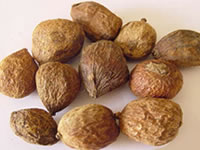DETAILS
Randia dumetorum
English: Indigoberry
Sanskrit/Indian: Mainphal
Russian: Рандия dumetorum

General information:
Randia dumetorum is a large deciduous thorny shrub belonging to family Rubiaceae. It is also known as a Catunaregam spinosa (Thumb.) Tirveng. It occurs in almost throughout India up to 4,000 ft attitude. Leaves simple, obovate, wrinkled, shiny and pubescent. Flowers white, fragrant, solitary, seen on at the end of short branches. Fruits globose, smooth berries with longitudinal ribs; yellow when ripe. Seeds many, compressed, embedded in the dark fetid pulp.
Constituents:
R. Dumetorum: Fruits/ seeds- citric & tartaric acids; randianin – sandianin; Randia Acid, ursosaponin, dumetoronins A,B,C,D,E&F; randoside A; Arachidic, Lignoceric, Linoleic, Oleic, Palmitic & stearic acids etc.
Benefits:
- Randia dumetorum has multiple applications in traditional medicine because it exhibit Analgesic, Antifertility, Antibacterial, Anti-inflammatory, Antiulcer, and Protective effects.
- Fruit
It cures abscess, ulcers, inflammation, wounds, tumours, skin diseases and have antibacterial activity. The pulp of fruit is believed by many practitioners to also have anthelmintic properties, and also used as an abortiffcient as folklore. - Bark
The bark is astringent and is given in cases of diarrhoea and dysentery. It is administered internally and applied externally in the form of paste in rheumatism and to relieve pain of bruises and boneaches during fevers and to disperse abscesses.
